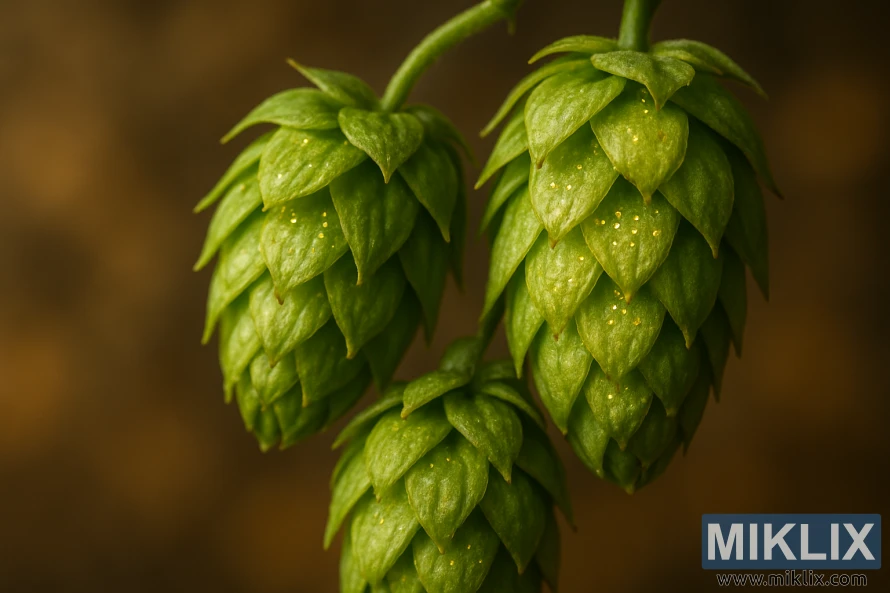Image: Centennial Hops Close-Up
Published: July 30, 2025 at 7:31:26 AM UTC
Last updated: September 27, 2025 at 11:27:48 AM UTC
Fresh Centennial hops glow with golden lupulin under warm light, highlighting their citrusy, piney character and role in classic American craft brewing.
The image presents an intimate and striking close-up of Centennial hop cones, their lush green forms standing out vividly against a softly blurred backdrop of warm, earthy tones. Each cone is composed of overlapping, scale-like bracts that fold tightly around the core, creating a layered texture reminiscent of a pinecone, yet with a delicate, papery quality. Nestled within these bracts are glimmers of golden lupulin, tiny resinous glands that sparkle like flecks of dust caught in sunlight. These pinpoints of gold, glowing subtly under the gentle, warm lighting, hint at the immense brewing potential locked within. They are the source of the hop’s essential oils and alpha acids, the compounds that impart bitterness, flavor, and aroma to beer. Their visibility in such detail conveys both the beauty and importance of this plant in the world of brewing.
The cones themselves appear almost alive, their vibrant green hues ranging from deep forest to lighter, fresh-spring shades. The lighting accentuates these tonal variations, casting soft highlights across the bracts while leaving the recesses in gentle shadow, lending the image a sense of three-dimensionality and depth. The blurred background, with its muted browns and ambers, enhances the vibrancy of the cones by contrast, while also evoking the warmth of malt, wood, or the interior of a rustic brewhouse. This pairing of foreground and background creates a sensory bridge, suggesting not just the physical qualities of the hops but also their eventual role in crafting a finished beer that harmonizes earth, grain, and greenery into a complex whole.
What makes the image particularly evocative is the suggestion of aroma and taste it conjures. The Centennial hop, often referred to as a “super Cascade,” is celebrated for its balanced yet expressive profile, and the photograph seems to translate these intangible qualities into visual form. One can almost smell the bright notes of lemon and orange peel mingling with delicate floral accents, underpinned by a resinous backbone of pine. The golden flecks of lupulin glistening within the cones are the silent carriers of these sensations, inviting the imagination to anticipate the burst of fragrance released when the bracts are gently crushed between the fingers. This visual cue ties the viewer not just to the plant itself but to the entire brewing journey, from field to fermenter to glass.
There is also an underlying sense of reverence in how the hops are portrayed. By focusing so closely, the image elevates what might otherwise be seen as a mere agricultural product into something almost jewel-like in its intricacy and value. Each cone is shown as a natural masterpiece, engineered by both biology and cultivation to fulfill a very specific and cherished role. The golden lupulin glistening within serves as both a literal highlight and a symbolic one, reminding us that within these small, fragile structures lies the power to shape entire styles of beer, from crisp pale ales to robust IPAs. The photograph, in its intimacy and warmth, becomes less a simple study of botany and more a celebration of the artistry inherent in brewing.
In its quiet detail, the image captures not only the physical beauty of Centennial hops but also their larger significance. It is a portrait of possibility, of transformation, and of tradition. The cones hang with a quiet dignity, poised between nature and craft, carrying within them the potential to inspire aromas, flavors, and experiences that will unfold far beyond this moment. The viewer is left with a sense of anticipation, as though these hops, still fresh and unspent, are on the cusp of becoming part of something much greater: a beer that tells their story through every sip.
The image is related to: Hops in Beer Brewing: Centennial

